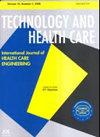Exploring the efficacy of structured nursing via web-based interaction platforms in sustaining hemodialysis patients.
IF 1.4
4区 医学
Q4 ENGINEERING, BIOMEDICAL
引用次数: 0
Abstract
BACKGROUND Discussed based on the network interactive platform of structured care for patients with chronic renal failure (CRF) in the process of hemodialysis. OBJECTIVE This study seeks to elucidate the application value of structured nursing, deployed through network interaction platforms, in sustaining patients undergoing maintenance hemodialysis. METHODS A total of 62 patients diagnosed with Chronic Renal Failure (CRF) between April 2022 and August 2023 were randomly allocated into two distinct care groups: conventional and structured nursing care based on a web-interactive platform. Both cohorts were comparatively analyzed with respect to psychological states, quality of life within therapeutic interventions, and relationships with complications. Renal function indicators, including Creatinine Clearance (Ccr), Serum Creatinine (SCr), and Blood Urea Nitrogen (BUN), were subjected to Pearson analysis to appraise their predictive value in prognostication, while Receiver Operating Characteristic (ROC) curve analysis was constructed to further discern their diagnostic precision. RESULTS Post-intervention, notable improvements were observed in the emotional states of patients in both cohorts, with the structured care group exhibiting significantly lower Self-rating Anxiety Scale (SAS) and Self-rating Depression Scale (SDS) scores (p< 0.05). Furthermore, patients under the web-interactive structured nursing regimen demonstrated superior overall adherence, a reduced incidence rate of complications, and markedly higher scores in quality of life assessments compared to those under conventional care (p< 0.05). The derived cut-off values for Ccr, SCr, and BUN were 32.5 ml/min, 251.5 umol/L, and 14.5 mmol/L, respectively, with sensitivities and specificities pegged at 0.645% and 0.645% for Ccr, 0.774% and 0.548% for SCr, and 0.774% and 0.774% for BUN. The corresponding areas under the ROC curve (AUC) for each parameter were 0.816, 0.653, and 0.856, respectively. CONCLUSION Comprehensive hemodialysis care for patients with chronic renal failure can improve self-care ability to improve quality of life and reduce the incidence of complications, which has great potential for clinical progress and is worthy of further research.探索通过网络互动平台对血液透析患者进行结构化护理的效果。
摘要】目的探讨基于网络互动平台的结构化护理在慢性肾功能衰竭(CRF)患者血液透析过程中的应用价值。方法将 2022 年 4 月至 2023 年 8 月期间确诊为慢性肾功能衰竭(CRF)的 62 例患者随机分配到两个不同的护理组:常规护理组和基于网络互动平台的结构化护理组。对两组患者的心理状态、治疗干预中的生活质量以及与并发症的关系进行了比较分析。对包括肌酐清除率(Ccr)、血清肌酐(SCr)和血尿素氮(BUN)在内的肾功能指标进行了皮尔逊分析,以评估其在预后中的预测价值,同时构建了接收者操作特征曲线(ROC)分析,以进一步确定其诊断精度。结果 干预后,两组患者的情绪状态均有明显改善,结构化护理组的焦虑自评量表(SAS)和抑郁自评量表(SDS)得分明显降低(P< 0.05)。此外,与接受传统护理的患者相比,接受网络交互式结构化护理方案的患者总体依从性更好,并发症发生率更低,生活质量评估得分明显更高(P< 0.05)。得出的 Ccr、SCr 和 BUN 临界值分别为 32.5 毫升/分钟、251.5 毫摩尔/升和 14.5 毫摩尔/升,Ccr 的敏感性和特异性分别为 0.645% 和 0.645%,SCr 的敏感性和特异性分别为 0.774% 和 0.548%,BUN 的敏感性和特异性分别为 0.774% 和 0.774%。结论对慢性肾功能衰竭患者进行全面的血液透析护理,可以提高患者的自我护理能力,从而改善患者的生活质量,降低并发症的发生率,具有很大的临床推广潜力,值得进一步研究。
本文章由计算机程序翻译,如有差异,请以英文原文为准。
求助全文
约1分钟内获得全文
求助全文
来源期刊

Technology and Health Care
HEALTH CARE SCIENCES & SERVICES-ENGINEERING, BIOMEDICAL
CiteScore
2.10
自引率
6.20%
发文量
282
审稿时长
>12 weeks
期刊介绍:
Technology and Health Care is intended to serve as a forum for the presentation of original articles and technical notes, observing rigorous scientific standards. Furthermore, upon invitation, reviews, tutorials, discussion papers and minisymposia are featured. The main focus of THC is related to the overlapping areas of engineering and medicine. The following types of contributions are considered:
1.Original articles: New concepts, procedures and devices associated with the use of technology in medical research and clinical practice are presented to a readership with a widespread background in engineering and/or medicine. In particular, the clinical benefit deriving from the application of engineering methods and devices in clinical medicine should be demonstrated. Typically, full length original contributions have a length of 4000 words, thereby taking duly into account figures and tables.
2.Technical Notes and Short Communications: Technical Notes relate to novel technical developments with relevance for clinical medicine. In Short Communications, clinical applications are shortly described. 3.Both Technical Notes and Short Communications typically have a length of 1500 words.
Reviews and Tutorials (upon invitation only): Tutorial and educational articles for persons with a primarily medical background on principles of engineering with particular significance for biomedical applications and vice versa are presented. The Editorial Board is responsible for the selection of topics.
4.Minisymposia (upon invitation only): Under the leadership of a Special Editor, controversial or important issues relating to health care are highlighted and discussed by various authors.
5.Letters to the Editors: Discussions or short statements (not indexed).
 求助内容:
求助内容: 应助结果提醒方式:
应助结果提醒方式:


